what will cause your lower leg to look like a rash
What autoimmune conditions cause a rash on the skin? These are the most common autoimmune diseases that may cause rashes on your skin:
- Lupus
- Sjogren'southward syndrome
- Dermatomyositis
- Psoriasis
- Eczema
- Hypothyroidism & myxedema
- Celiac affliction
- Scleroderma
- Lichen planus
- Behçet's disease
An autoimmune disease occurs when your body's immune arrangement attacks salubrious cells within the body. This dysfunctional immune response may pb to various symptoms, like hair loss, pare rash, or fifty-fifty joint pain.
More than 20 million Americans suffer from autoimmune diseases such equally rheumatoid arthritis or Hashimoto'southward thyroiditis.
Why practise autoimmune weather condition cause a rash? Autoimmune atmospheric condition may cause a rash because they trigger inflammation in skin cells. These diseases are ofttimes characterized by chronic inflammation in your internal organs, your peel, and everywhere in betwixt.
What do autoimmune rashes look similar? Autoimmune rashes can expect like scaly red patches, purplish bumps, or more. The appearance of autoimmune rashes will be unlike, depending on which autoimmune status is triggering the skin rash.
For example, cutaneous lupus may crusade a scaly red patch that does not hurt or itch. Scalp psoriasis may cause plaque buildup that results in hair loss. Lichen planus may cause purplish, itchy, flat bumps on your skin.
Learn more about the autoimmune conditions that may cause skin rashes. Here are 10 of the conditions that commonly crusade autoimmune rashes and pictures of what these autoimmune skin disorders might look similar on the boilerplate patient.
Lupus
2-thirds of lupus patients will develop a pare condition. Peel disease in lupus may present every bit rashes or sores and lesions.
What autoimmune disease causes sunday rash? Lupus is the autoimmune disease that is near likely to crusade a sun-related rash. Up to 70% of lupus cases are worsened past sun exposure or extended time under fluorescent lights, a status known as "photosensitivity." Many lupus-related rashes appear on areas of the skin near heavily exposed to sunlight.
Unfortunately, people with lupus may also experience systemic flare-ups afterwards lord's day exposure. Symptoms may include skin inflammation as well every bit fatigue, joint hurting, and more.

Cutaneous lupus refers to a grade of lupus that only affects the skin. (When people say "lupus," they're commonly talking about systemic lupus erythematosus (SLE), which is different from cutaneous lupus.) You can have multiple forms of lupus or only one form.
The 3 types of cutaneous lupus:
- Acute cutaneous lupus often causes a butterfly rash (AKA malar rash) on your cheeks. This should not lead to scarring. Nevertheless, this area will be sensitive to sunlight, and information technology may await like a sunburn.
- Subacute cutaneous lupus also occurs mostly on sun-exposed areas of your skin. The affected areas should not scar or itch. However, the affected areas may become discolored and scaly.
- Chronic cutaneous lupus is sometimes known as discoid lupus, even though "discoid" is the most common form of chronic cutaneous lupus among many. Discoid lupus is very sensitive to sunlight and even fluorescent light, producing small amounts of ultraviolet radiation. Discoid lupus may somewhen pb to discoloration and scarring, though typically discoid lesions still do non crawling or injure. Discoid lesions on the caput tin cause hair to fall out permanently.
Neonatal lupus is a very rare condition that affects infants of mothers who accept some grade of lupus. At birth, the infant may exhibit a peel rash, low blood cell count, liver problems, or a slow heartbeat.
Sjögren's Syndrome
Sjögren's syndrome is an autoimmune disease that tin can crusade dry eyes and dry oral cavity. Mainly affecting women over 40, Sjögren's syndrome affects up to 3 1000000 Americans.
Individuals with Sjögren'south may develop a skin rash.
Sjögren's syndrome may lead to the following peel problems:
- Dry, rough peel (AKA xerosis)
- Blood spots on your legs (AKA purpura) due to blood vessel inflammation (AKA vasculitis)
- Purple-to-cherry skin rash that does non lighten under force per unit area
- Red, ring-shaped skin lesions effectually a pale center (AKA annular erythema)
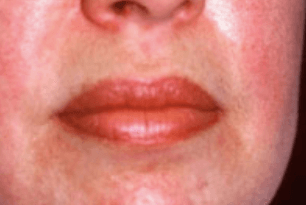
If you experience purpura or annular erythema, schedule a visit with your medico or dermatologist correct away.
Although Sjögren'south syndrome does not seem to reduce life expectancy, information technology can reduce your quality of life. For instance, if Sjögren'due south causes dry out mouth, you may develop gum affliction and cavities, which may drastically reduce your quality of life.
Dermatomyositis
Dermatomyositis is a very rare autoimmune disorder that affects a few thousand Americans, including juveniles. Common symptoms include:
- Muscle weakness
- Trouble swallowing (AKA dysphagia)
- Difficulty talking
- Fatigue
- Red or purple skin rash on a sun-exposed area
- Calcium deposits underneath your peel (AKA calcinosis)
- Inflammation around your fingernails
Dermatomyositis-related pare rashes near often occur in these 8 parts of the body:
- Eyelids
- Nose
- Cheeks
- Back
- Upper breast
- Elbows
- Knees
- Duke
Individuals who experience pare rash but non muscle weakness likely endure from amyopathic dermatomyositis, also called "dermatomyositis sine myositis".
Psoriasis
Psoriasis is a common autoimmune disorder. The most common symptom of psoriasis is a scaly peel rash. These skin issues may occur anywhere on the body, but psoriasis almost commonly affects the elbows, knees, lower back, and scalp.
Psoriasis may be itchy and cause pain. Make sure you do not scratch or itch the psoriasis rash, which can pb to bleeding and infection.
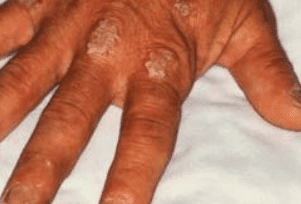
There are seven types of psoriasis:
- Plaque psoriasis is the most common type of psoriasis skin rash. Pocket-sized red bumps course, then become scaly and larger. Upward to 90% of psoriasis patients experience this blazon of rash. 15% of people with plaque psoriasis develop psoriatic arthritis.
- Nail psoriasis leads to pits in fingernails and toenails and may issue in loss of nails.
- Scalp psoriasis forms flakes that look similar dandruff and peradventure hair loss.
- Inverse psoriasis (AKA intertriginous psoriasis) occurs in the pare folds of individuals with psoriasis. Overweight individuals are specially vulnerable to this form of psoriasis.
- Pustular psoriasis causes pus-filled bumps, usually on the feet and easily. These bumps may dry and get brown and scaly.
- Guttate psoriasis forms picayune red spots all over your skin after an infection.
- Erythrodermic psoriasis is a rare, life-threatening type of psoriasis. It includes a large patch of cherry-red skin, itching, and severe hurting. It may exist caused by intense sunburn, sure medications, or untreated psoriasis.
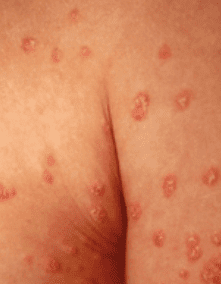
What autoimmune affliction causes an itchy rash? Some autoimmune diseases that may cause an itchy rash are cutaneous lupus, oral lichen planus, and erythrodermic psoriasis.
Eczema
Eczema is an itchy peel condition. Children are at a higher risk of getting eczema than adults. Though eczema oftentimes goes away after puberty, it tin can persist into adulthood.
The two bones types of eczema are:
- Atopic dermatitis: This is the well-nigh common course of eczema. Whether autoimmune or genetic, atopic dermatitis triggers a skin rash when the skin's natural defenses are weakened. Many people experience atopic dermatitis, asthma, and hay fever together.
- Contact dermatitis: This is an allergic reaction (or exposure to a chemic irritant), leading to an itchy skin rash. Contact dermatitis may also issue in fluid-filled blisters or scaly patches.
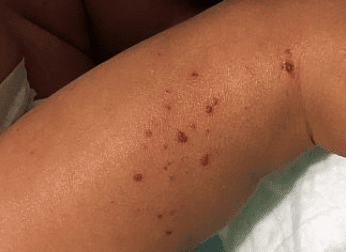
Eczema can cause skin problems all over your trunk, especially on:
- Hands
- Feet
- Arms
- Legs
- Elbow
- Knees
- Scalp
- The back of the neck
What autoimmune diseases cause an itchy scalp? Psoriasis, eczema, and lichen planus are the autoimmune diseases that almost commonly cause an itchy scalp.
Hypothyroidism & Myxedema
Astringent, untreated hypothyroidism may lead to myxedema, which either means "severely avant-garde hypothyroidism" or skin bug related to severely advanced hypothyroidism.
Myxedema leads to peel changes, though these may not technically be considered rashes. Myxedema may result in swelling and thickening of your pare.
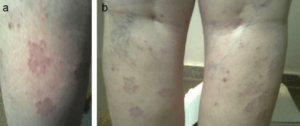
Skin changes related to myxedema are most mutual:
- On your lower legs
- On the confront
- On your natural language
Even so, these changes can occur anywhere on your body.
Severe hypothyroidism may as well trigger these 9 symptoms:
- Goiter
- Fatigue
- Brittle pilus
- Cold sensitivity
- Weight proceeds
- Low heart rate
- Depression claret pressure
- Constipation
- Depression
Myxedema and severe hypothyroidism require firsthand treatment and management. "Myxedema crisis" is when the body no longer tolerates the astringent hypothyroidism symptoms. Your body starts to shut downward. Myxedema crisis may result in coma, seizures, and expiry.
Telephone call your doctor or emergency services immediately if you lot believe y'all're having a myxedema crisis.
If you think you may have hypothyroidism , schedule a consult at PrimeHealth in Denver, Colorado. 90% of hypothyroidism cases are autoimmunity-related. Click hither to learn how we treat hypothyroidism differently than other doctors.
Celiac Disease
Experts estimate that almost 1% of Americans suffer from celiac affliction. Although celiac illness well-nigh frequently triggers gastrointestinal distress, information technology may also trigger an autoimmune rash.
Celiac disease occurs when gluten causes excessive gut inflammation, which may cause the following symptoms:
- Anemia
- Fatigue
- Gas
- Stomach growling
- Bloating
- Constipation
- Diarrhea
- Depression
- Skin rash
Celiac affliction may result in "dermatitis herpetiformis", an itchy, blistering rash on your pare. This usually appears on the elbows, knees, or buttocks.
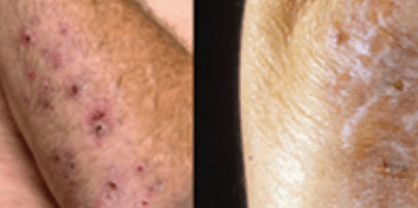
Surprisingly, fewer than 10% of individuals with celiac experience both skin problems and the more common digestive symptoms.
Scleroderma
Too known as systemic sclerosis, scleroderma is a status in which your immune system mistakenly attacks your own good for you tissues, namely, the skin.
Scleroderma as well affects the following:
- Claret vessels
- Digestive system
- Heart
- Joints
- Kidneys
- Lungs
- Muscles
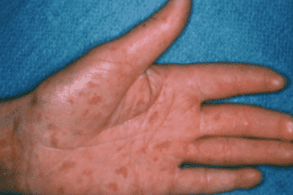
When you have scleroderma, your skin changes in appearance and feel, due to increased collagen production. It may get shiny and thicker.
Morphea is sometimes synonymous with scleroderma, but morphea is actually a astringent type of scleroderma. Morphea specifically refers to oval-shaped areas of thick, red skin.
Hazard factors for scleroderma include:
- Female gender
- African-American or Native American heritage
- Exposure to silica grit
- Certain chemotherapy drugs
Lichen Planus
Oral lichen planus is an autoimmune disease that may trigger swelling and irritation on your peel, scalp, nails, genitals, and mucous membranes.
Lichen planus typically causes imperial, itchy, apartment bumps on the skin. It may too effect in lacy-white lesions in the mouth.
Behçet's disease
Behçet's disease is a very rare autoimmune disorder that leads to blood vessel inflammation (vasculitis).
Behçet's disease symptoms include:
- Skin rashes/lesions
- Oral cavity sores
- Eye inflammation
- Genital sores
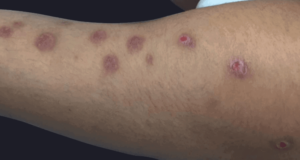
Autoimmune Blistering Diseases
We've been talking a lot most pare rashes. Yet, some autoimmune conditions can crusade skin blistering, too.
Also known as autoimmune bullous diseases, here are the most mutual autoimmune diseases that can cause blistering:
- Epidermolysis bullosa acquisita
- IgA-mediated bullous dermatoses
- Ocular cicatricial pemphigoid
- Bullous pemphigoid
- Pemphigus
Testing for Autoimmune Disease
No unmarried test is designed to test for all autoimmune diseases. If you're seeking a diagnosis, several blood tests can assist your healthcare provider determine if you have an autoimmune affliction.
Here are iv common diagnostic tests for autoimmune disease:
- Antinuclear Antibiotic (ANA)
- Autoantibodies
- C-Reactive Poly peptide (CRP)
- Erythrocyte Sedimentation Rate (ESR)
Treatment Options
How do yous treat an autoimmune rash? The all-time way to care for autoimmune rash (and autoimmune disorders in full general) is to identify and treat the underlying crusade. There are many possible causes of autoimmunity.
Because there are multiple potential causes, conventional doctors ofttimes say autoimmune disorders are incurable. And then, they focus on treating the symptoms with anti-inflammatory drugs and other medications that often trigger adverse side furnishings and may lead to flare-ups.
Integrative medicine and functional medicine doctors are more equipped to diagnose and treat the underlying cause of autoimmune disease. Conventional doctors typically manage symptoms, instead of addressing the underlying cause.
Click here today to schedule a free phone consultation with us. We take successfully treated many patients with autoimmune rashes. Hither at PrimeHealth, we empower patients to take an active function in their whole-person health.
Sources
- Grönhagen, C. M., & Nyberg, F. (2014). Cutaneous lupus erythematosus: An update. Indian dermatology online journal, 5(1), 7. Full text: https://www.ncbi.nlm.nih.gov/pmc/articles/PMC3937495/
- Talha, B., & Swarnkar, S. A. (2019). Xerostomia. In StatPearls [Cyberspace]. StatPearls Publishing. Total text: https://world wide web.ncbi.nlm.nih.gov/books/NBK545287/
- Nair, P.A., Badri, T. (2020). Psoriasis. Full text: https://www.ncbi.nlm.nih.gov/books/NBK448194/
- Badri, T., Kumar, P., & Oakley, A. M. (2017). Plaque Psoriasis. Full text: https://world wide web.ncbi.nlm.nih.gov/books/NBK430879/
- Belgrave, D. C., Simpson, A., Buchan, I. E., & Custovic, A. (2015). Atopic dermatitis and respiratory allergy: what is the link. Current dermatology reports, 4(4), 221-227. Total text: https://world wide web.ncbi.nlm.nih.gov/pmc/articles/PMC4635175/
- Reunala, T. (1998). Dermatitis herpetiformis: coeliac affliction of the skin. Abstract: https://pubmed.ncbi.nlm.nih.gov/9814827/
- Castro, C., & Gourley, M. (2010). Diagnostic testing and interpretation of tests for autoimmunity. Journal of Allergy and Clinical Immunology, 125(2), S238-S247. Total text: https://www.ncbi.nlm.nih.gov/pmc/articles/PMC2832720/
Source: https://primehealthdenver.com/autoimmune-rash/
0 Response to "what will cause your lower leg to look like a rash"
Post a Comment